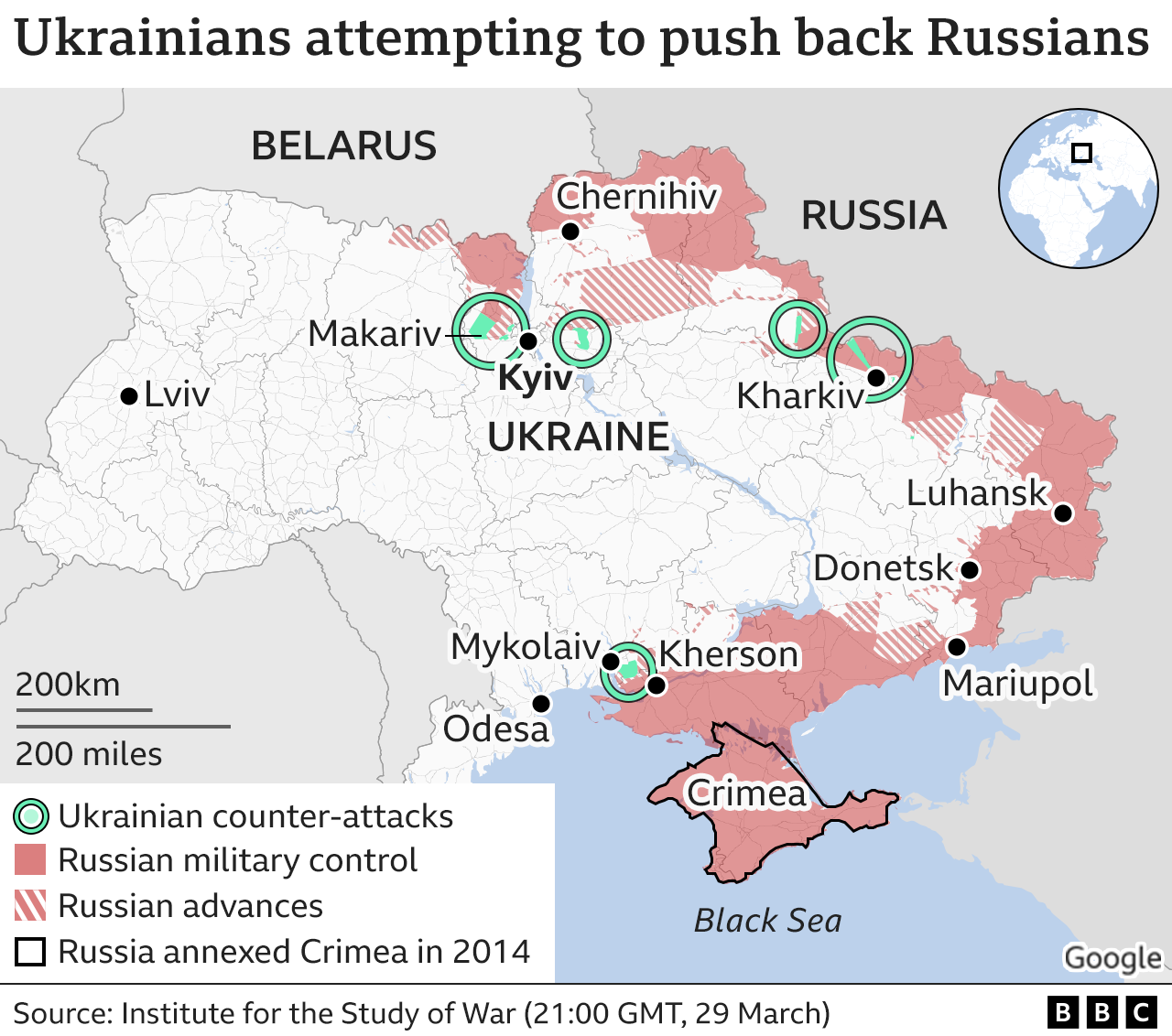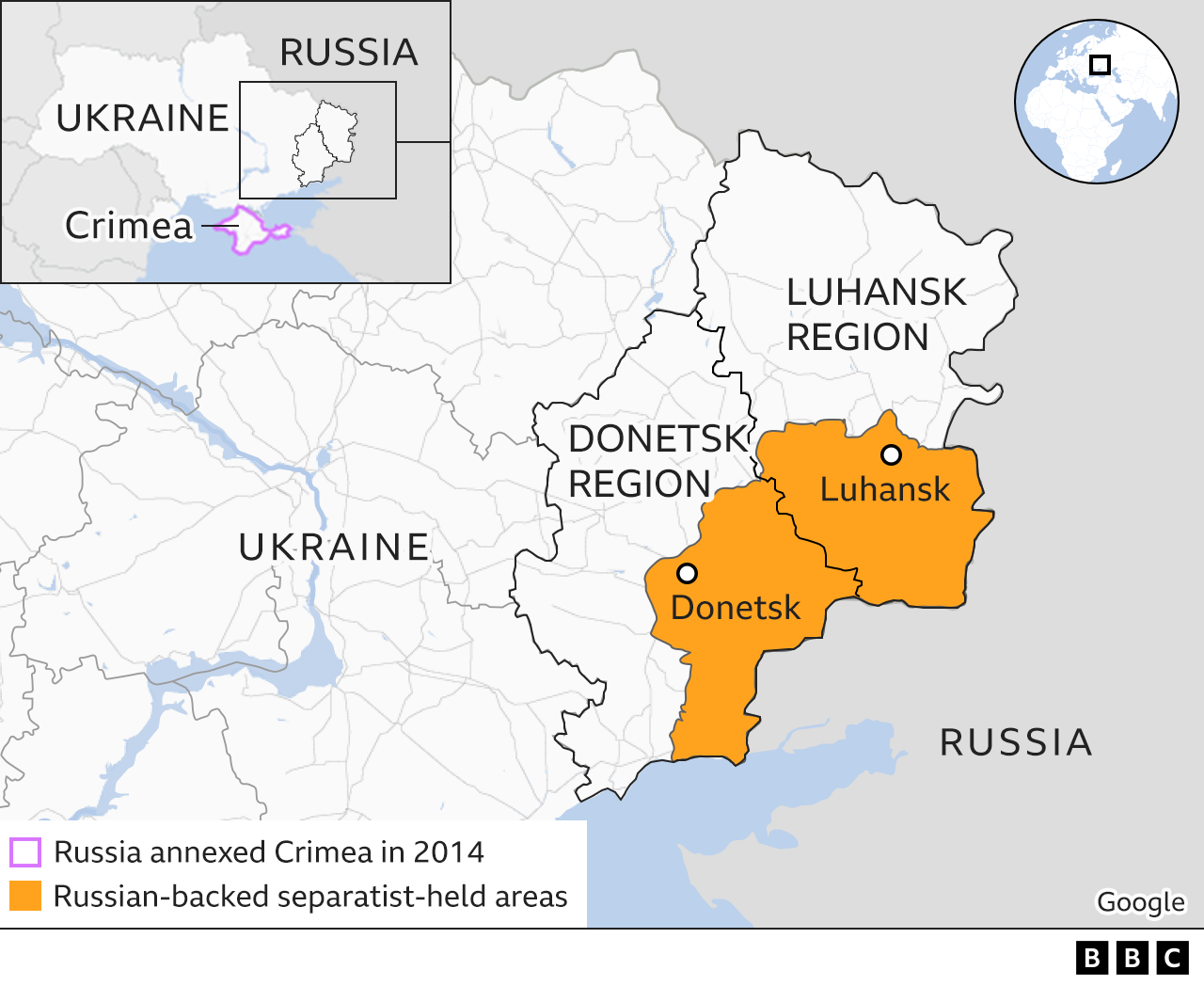Why has Russia invaded Ukraine and what does Putin want?
Why has Russia invaded Ukraine and what does Putin want?
By Paul Kirby
BBC News
When Vladimir Putin shattered the peace in Europe by unleashing war on a democracy of 44 million people, his justification was that modern, Western-leaning Ukraine was a constant threat and Russia could not feel "safe, develop and exist".
But after five weeks of bombardment, thousands of deaths in ruined cities and the displacement of more than 10 million people inside Ukraine and beyond, the questions remain: what is his aim and is there a way out?
What was Putin's goal?
The Russian leader's initial aim was to overrun Ukraine and depose its government, ending for good its desire to join the Western defensive alliance Nato. But the invasion has become bogged down and he appears to have scaled back his ambitions.
Launching the invasion on 24 February he told the Russian people his goal was to "demilitarise and de-Nazify Ukraine", to protect people subjected to what he called eight years of bullying and genocide by Ukraine's government. "It is not our plan to occupy the Ukrainian territory. We do not intend to impose anything on anyone by force," he insisted.
This was not even a war or invasion, he claimed, merely the fiction of a "special military operation" that Russian state-controlled media are required to adopt.
The claims of Nazis and genocide in Ukraine were completely unfounded, but it was clear Russia saw this as a pivotal moment. "Russia's future and its future place in the world are at stake," said foreign intelligence chief Sergei Naryshkin.
Russia's military aimed to sweep into the capital Kyiv, invading from Belarus in the north, as well as from the south and east.
Foreign Minister Sergei Lavrov spoke of freeing Ukraine from oppression, while Ukraine's democratically elected President Volodymyr Zelensky said "the enemy has designated me as target number one; my family is target number two".
But Ukraine's fierce resistance has caused heavy losses and, in some areas, driven Russian forces back.
Has Putin changed his aims?
Russia does appear to have lowered its ambitions, claiming it has "generally accomplished" the aims of the invasion's first phase, which it defined as considerably reducing Ukraine's combat potential.
Russia announced at peace talks that it would be "drastically reducing" its military operations around the capital, and around the northern city of Chernihiv.
That is yet to be confirmed and Ukraine's President Zelensky has said Ukraine can only trust concrete results, not words.
The war continues, particularly in the east and the south, where Russian forces are trying to create a land corridor along the south coast, east from Crimea to the Russian border.
A month into the invasion, Russia declared its main goal was the "liberation of Donbas" - broadly referring to Ukraine's eastern regions of Luhansk and Donetsk. More than a third of this area was already seized by Russian-backed separatists in a war that began in 2014.
Ahead of the invasion it was clear President Putin wanted all of the east, recognising the whole area as belonging to two Russian puppet statelets. The head of the Luhansk statelet has suggested holding a referendum on joining Russia, similar to an internationally discredited vote held in Crimea in 2014.
Beyond his military goals, President Putin's broader demand is to ensure Ukraine's future neutrality. The Ukrainians have offered that in return for security guarantees from allies, as part of a wide-ranging peace plan presented in talks in Turkey.
Why Putin wants a neutral Ukraine
Since Ukraine achieved independence in 1991, as the Soviet Union collapsed, it has gradually veered towards the West - both the EU and Nato.
Russia's leader has sought to reverse that, seeing the fall of the Soviet Union as the "disintegration of historical Russia". He has claimed Russians and Ukrainians are one people and denied Ukraine its long history: "Ukraine never had stable traditions of genuine statehood," he asserted.
It was his pressure on Ukraine's pro-Russian leader, Viktor Yanukovych, not to sign a deal with the European Union in 2013 that led to protests that ultimately ousted the Ukrainian president in February 2014.
Russia then seized Ukraine's southern region of Crimea and triggered a separatist rebellion in the east and a war that claimed 14,000 lives.
As he prepared to invade in February, he tore up an unfulfilled 2015 Minsk peace deal and accused Nato of threatening "our historic future as a nation", claiming without foundation that Nato countries wanted to bring war to Crimea.
What would neutrality look like?
Before Ukraine presented its plans, Russia said it was considering a "neutral, demilitarised" Ukraine with its own army and navy, along the lines of Austria or Sweden, which are both EU members. Austria is neutral, while Sweden is non-aligned.
President Zelensky had already declared that Ukrainians now understood they would will not be admitted to Nato: "It's a truth and it must be recognised."




Comments
Post a Comment